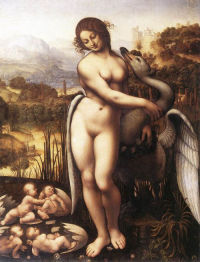Leda and the Swan (copy after Leonardo) 16th century
According to Greek myth, Leda was seduced by the God Zeus, who came to her at the river in the form of a swan. Their union resulted in the creation of Helen of Troy, Clytemnestra, Castor and Pollux, who hatched from two eggs.
Leonardo's interest in the theme is testified in a group of surviving drawings, in which he explored different compositional solutions, first with Leda kneeling and then standing. Drawings at Chatworth, Derbyshire, and the Museum Boijmans Van Beuningen, Rotterdam, can be dated to around 1506-08 and show Leda standing, but it would seem that Leonardo was already working on the theme of a kneeling Leda as early as 1504 as preliminary sketches appear on drawings related to the Battle of Anghiari mural, on which at that time Leonardo was working.
Three sketches of the Leda have drawn framing outlines around the composition, suggesting that Leonardo did intend to execute a painting of Leda at some point, although no painting of the subject by his hand survives today. A painted copy by Leonardo's pupil Giampetrino now in the Staatliche Museen, Berlin, vividly evokes the master's idea for a kneeling Leda, while a drawn copy by Raphael reflects Leonardo's standing version of the theme. Leonardo's own surviving drawings for the Leda include botanical studies drawn from nature and speak of the timeless notions of fecundity, birth, and nature's regenerative power.
- Medium Oil on wood panel
- Size 69.5 x 73.7 cm
- Location Collection of the Earl of Pembroke


